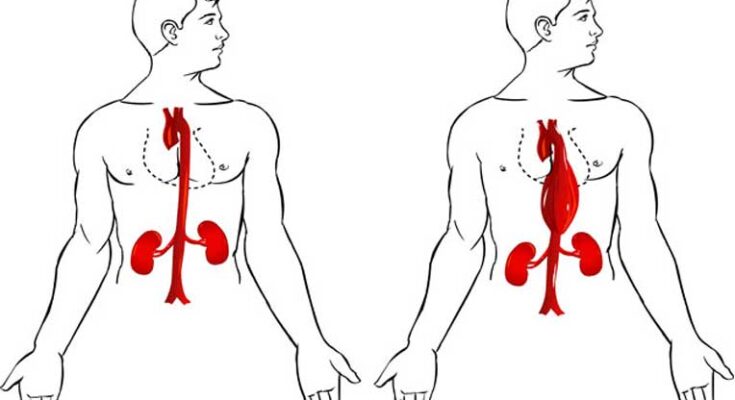Aortic Aneurysm Symptoms: An aortic aneurysm is a serious health condition that requires immediate attention and understanding.
In this comprehensive guide, we delve into the intricacies of aortic aneurysms, highlighting their symptoms, causes, and the critical nature of early detection and management.
What is an Aortic Aneurysm?
An aortic aneurysm is a medical condition characterized by the enlargement or bulging of the aorta, the main artery that carries blood from the heart to the rest of the body. This enlargement can weaken the artery’s walls, increasing the risk of a rupture, which can be life-threatening. Understanding the nature of aortic aneurysms is crucial for early detection and effective management.
Types of Aortic Aneurysms
Aortic aneurysms are primarily categorized into two types:
- Thoracic Aortic Aneurysms (TAA): These occur in the part of the aorta running through the chest. They are less common but potentially more hazardous as they are often asymptomatic until they become severe.
- Abdominal Aortic Aneurysms (AAA): These are found in the part of the aorta that passes through the abdomen. They are more common and can be detected during routine medical exams or screenings, especially in individuals at risk.
Incidence and Risk Factors
The incidence of aortic aneurysms varies, with factors such as age, gender, genetic predisposition, and lifestyle choices playing a significant role. General statistics indicate:
- Age and Gender: Most common in men over 60, but women are also at risk, particularly as they age.
- Genetic Factors: A family history of the condition significantly increases the risk.
- Lifestyle Factors: Smoking, high blood pressure, and high cholesterol are key risk factors.
Importance of Awareness and Regular Check-Ups
Early detection of aortic aneurysms can significantly reduce the risk of complications. Regular check-ups, particularly for those with risk factors, are essential for maintaining cardiovascular health. If you suspect you might be at risk, consult with a healthcare provider for appropriate screening and preventative measures.
Symptoms of Aortic Aneurysms
Recognizing the symptoms of aortic aneurysms is crucial for timely medical intervention and effective treatment. This section delves into the common symptoms associated with this condition, highlights the differences between thoracic and abdominal aortic aneurysms, and underscores symptoms that necessitate immediate medical attention.
Common Symptoms of Aortic Aneurysms
Aortic aneurysms often develop without noticeable symptoms, making them challenging to detect. However, when symptoms do occur, they can include:
- Pain: A deep, constant pain in the chest or abdomen, often described as a throbbing or gnawing sensation, is a common symptom. This pain may radiate to the back or legs.
- Shortness of Breath: If the aneurysm presses against respiratory structures, it can lead to breathing difficulties.
- Hoarseness: Pressure on the vocal cords from a thoracic aneurysm can cause voice changes.
- Swelling: In some cases, swelling of the limbs or other areas may occur due to disrupted blood flow.
Differences in Symptoms: Thoracic vs. Abdominal Aortic Aneurysms
Though some symptoms overlap, thoracic and abdominal aortic aneurysms have distinct characteristics:
- Thoracic Aortic Aneurysms: These typically manifest with symptoms like sharp chest pain, back pain, difficulty swallowing, and hoarseness.
- Abdominal Aortic Aneurysms: The most common signs include a pulsating feeling near the navel, deep abdominal pain, and persistent back pain.
Symptoms Warranting Immediate Medical Attention
Certain symptoms indicate an urgent need for medical care, as they could signify a rupture or imminent rupture:
- Sudden, Intense Pain: A sharp, severe pain in the back or abdomen that comes on suddenly can be a sign of a ruptured aneurysm, which is a life-threatening emergency.
- Loss of Consciousness: Fainting or blackouts associated with aneurysm pain require immediate attention.
- Rapid Heart Rate and Shock: Symptoms like a fast heartbeat, clammy skin, nausea, and shock are critical signs.
Early recognition and diagnosis of aortic aneurysms are vital. If you experience any of these symptoms, especially those warranting immediate attention, seek medical care promptly. Regular check-ups and monitoring are essential for those at risk of aortic aneurysms, such as individuals with a family history of the condition, smokers, or those with hypertension.
Causes and Risk Factors for Aortic Aneurysms
Understanding the causes and risk factors associated with this condition is crucial for early detection and effective management.
In-Depth Discussion of Causes
The development of an aortic aneurysm can be attributed to several factors. Primarily, it occurs when the walls of the aorta weaken. Various conditions can lead to this weakening, such as:
- Genetic Factors: A family history of aortic aneurysms increases the likelihood of developing this condition.
- Medical Conditions: Certain diseases, including Marfan syndrome and Ehlers-Danlos syndrome, are known to affect the strength and elasticity of blood vessels.
Risk Factors: Age, Gender, and Lifestyle
The risk of developing an aortic aneurysm increases with certain demographic and lifestyle factors:
- Age: Individuals over the age of 60 are at a higher risk.
- Gender: Men are more likely to develop aortic aneurysms than women.
- Lifestyle Choices: Smoking and an unhealthy diet can contribute to the weakening of the aorta.
The Role of Hypertension and Atherosclerosis
Two of the most significant contributors to aortic aneurysms are hypertension (high blood pressure) and atherosclerosis (hardening of the arteries):
- Hypertension: High blood pressure can put extra strain on the walls of the aorta, leading to weakening over time.
- Atherosclerosis: The buildup of plaque in the arteries can lead to reduced elasticity and strength of the arterial walls, increasing the risk of an aneurysm.
Recognizing the causes and risk factors for aortic aneurysms is essential for prevention and early treatment. Regular check-ups, healthy lifestyle choices, and managing underlying conditions like hypertension are key to reducing the risk of this potentially life-threatening condition.
Complications of Aortic Aneurysms
Aortic aneurysms, characterized by the abnormal enlargement of the aorta, pose significant health risks due to potential complications. The two primary concerns are rupture and dissection, both of which require immediate medical attention.
Rupture: This is when the aneurysm breaks open, causing internal bleeding. A ruptured aortic aneurysm is a life-threatening emergency. It can lead to severe pain, low blood pressure, rapid heart rate, and possibly death if not treated promptly.
Dissection: This occurs when a tear develops in the aorta’s inner layer, causing blood to flow between the layers of the aortic wall. This condition can lead to a complete tear or rupture and is equally hazardous.
Recognizing Emergency Signs
Being aware of the signs indicating an emergency situation related to aortic aneurysms can be life-saving. Key symptoms include:
- Sudden, Intense Pain: Often described as a tearing sensation in the chest, abdomen, or back.
- Symptoms of Shock: Such as dizziness, rapid heartbeat, and fainting, indicating a possible rupture.
- Other Signs: Difficulty breathing, weakness, or numbness can also be indicative of complications.
It’s crucial to seek immediate medical assistance if these symptoms are experienced, as timely intervention is critical for survival in the case of aortic aneurysm complications.
Diagnosis and Screening of Aortic Aneurysms
The diagnosis of this condition employs a range of imaging techniques, each with its unique benefits:
- Ultrasound: This non-invasive method is highly effective for screening and initial diagnosis, particularly for abdominal aortic aneurysms. Its accessibility and safety make it a preferred choice.
- Computed Tomography (CT) Scan: Offering detailed images, CT scans are invaluable in assessing the size and shape of an aneurysm. They provide crucial insights into the risk of rupture.
- Magnetic Resonance Imaging (MRI): MRI offers exceptional detail and is particularly useful in evaluating the aortic aneurysm’s relation to surrounding structures.
The Importance of Early Detection
Early detection of aortic aneurysms is vital. Recognizing an aneurysm early can significantly reduce the risk of life-threatening complications like rupture or dissection. Early detection allows for timely intervention and management, which can include surveillance, lifestyle changes, or surgical procedures when necessary.
Screening Recommendations for High-Risk Individuals
Screening for aortic aneurysms is particularly important for individuals at high risk. Key recommendations include:
- Age and Gender Considerations: Men aged 65 to 75 years who have ever smoked are advised to have a one-time screening for abdominal aortic aneurysms using an ultrasound.
- Family History: Individuals with a family history of aortic aneurysms should discuss early screening options with their healthcare provider.
- Other Risk Factors: Those with a history of hypertension, atherosclerosis, or specific genetic conditions should also consider early screening.
Regular screening and early detection are crucial for managing aortic aneurysms effectively. By adhering to these recommendations, high-risk individuals can take proactive steps towards safeguarding their health.
Treatment Options for Aortic Aneurysms
Managing aortic aneurysms effectively requires a comprehensive understanding of the various treatment options available. These options can broadly be classified into three categories: monitoring, medication, and surgery. Each method is tailored to suit the specific needs and condition of the patient, making the choice of treatment a critical decision.
Monitoring
- Routine Surveillance: This approach is often recommended for smaller aneurysms that pose minimal immediate risk. It involves regular check-ups and imaging tests to closely monitor the size and growth of the aneurysm.
- Lifestyle Modifications: Patients are advised to adopt heart-healthy lifestyle changes. This includes quitting smoking, maintaining a healthy diet, regular exercise, and controlling blood pressure.
Medication
- Blood Pressure Control: Medications such as beta-blockers and ACE inhibitors are prescribed to manage high blood pressure, a significant risk factor for aneurysm growth.
- Cholesterol Management: Statins and other cholesterol-lowering drugs help in reducing the risk of atherosclerosis, which can exacerbate an aneurysm.
Surgery
- Open Surgical Repair: This traditional procedure involves replacing the diseased section of the aorta with a synthetic graft.
- Endovascular Surgery: A less invasive option, this involves inserting a stent graft through a small incision in the leg to reinforce the weakened section of the aorta.
Criteria for Deciding the Best Course of Treatment
The choice of treatment is influenced by several factors:
- Size and Growth Rate: Larger aneurysms or those that grow rapidly are more likely to require surgery.
- Location and Shape: The aneurysm’s position and form can determine whether surgical intervention is possible or necessary.
- Patient’s Overall Health: Age, underlying health conditions, and the patient’s ability to withstand surgery are critical considerations.
- Risk of Rupture: High-risk aneurysms, due to size or symptoms, may necessitate more immediate surgical intervention.
However, the treatment of aortic aneurysms is a personalized process, demanding careful evaluation and regular consultations with healthcare professionals. Patients must be actively involved in their treatment plan, understanding the risks and benefits of each option. By doing so, the best possible outcomes can be achieved in managing this complex condition.
Prevention and Management of Aortic Aneurysms
Implementing these changes not only enhances overall heart health but also significantly reduces the risk of complications associated with aortic aneurysms.
- Healthy Diet: Adopt a heart-healthy diet rich in fruits, vegetables, whole grains, and lean proteins. Minimize the intake of saturated fats, trans fats, and cholesterol to keep blood vessels healthy.
- Regular Exercise: Engage in regular physical activity to maintain a healthy weight and reduce blood pressure. Activities like walking, swimming, or cycling are especially beneficial.
- Smoking Cessation: Smoking is a major risk factor for aortic aneurysms. Quitting smoking can drastically reduce the risk of aneurysm development and rupture.
- Blood Pressure Control: High blood pressure can exacerbate aneurysms. Managing blood pressure through lifestyle changes and medications is crucial.
- Cholesterol Management: High cholesterol can lead to plaque build-up in arteries, worsening aneurysms. Keeping cholesterol levels in check is vital.
- Limit Alcohol and Caffeine: Excessive consumption of alcohol and caffeine can contribute to high blood pressure and should be limited.
The Importance of Regular Check-Ups and Monitoring
Regular check-ups and monitoring play a pivotal role in the effective management of aortic aneurysms. These check-ups can help in:
- Early Detection: Regular medical examinations can help in the early detection of aneurysms, allowing for timely intervention.
- Monitoring Growth: Aortic aneurysms can grow over time. Regular imaging tests like CT scans, MRIs, or ultrasounds are essential to monitor their size and growth rate.
- Adjusting Treatment Plans: Frequent check-ups enable healthcare providers to adjust treatment plans as needed, based on the aneurysm’s progression.
- Preventing Complications: Regular monitoring can help in preventing severe complications like aneurysm rupture or dissection.
However, combining lifestyle changes with regular medical check-ups and monitoring forms the cornerstone of preventing and managing aortic aneurysms. This proactive approach not only ensures early detection and treatment but also significantly improves the quality of life and long-term outcomes for individuals with this condition.
FAQs on Aortic Aneurysms
1. What is an Aortic Aneurysm?
An aortic aneurysm is a bulge or enlargement in the aorta, the main artery that carries blood from the heart to the rest of the body. This condition can be dangerous as it increases the risk of the artery wall tearing (dissection) or rupturing.
2. Are There Different Types of Aortic Aneurysms?
Yes, there are two main types: thoracic aortic aneurysms (occurring in the chest) and abdominal aortic aneurysms (located in the abdomen). Each type affects a different part of the aorta and can have varying symptoms and risks.
3. What Causes Aortic Aneurysms?
Factors like high blood pressure, atherosclerosis (build-up of plaque in arteries), genetic conditions, and lifestyle factors (such as smoking) contribute to the development of aortic aneurysms.
4. What are the Symptoms of an Aortic Aneurysm?
Many aortic aneurysms are asymptomatic (don’t show symptoms). When symptoms occur, they can include chest or back pain, a pulsating feeling in the abdomen, and shortness of breath. It’s important to seek medical attention if you experience these symptoms.
5. How is an Aortic Aneurysm Diagnosed?
Aortic aneurysms are often discovered during routine medical exams or tests for other conditions. Imaging tests like ultrasound, CT scans, and MRIs are commonly used for diagnosis.
6. Can Aortic Aneurysms Be Prevented?
While not all aortic aneurysms can be prevented, risk factors like high blood pressure and smoking can be managed. Regular check-ups and leading a healthy lifestyle are key preventive measures.
7. What are the Treatment Options for Aortic Aneurysms?
Treatment varies based on the size and growth rate of the aneurysm. Options include regular monitoring, medications to manage blood pressure, and surgery (open or endovascular repair) in more severe cases.
8. Is an Aortic Aneurysm a Life-Threatening Condition?
It can be, particularly if the aneurysm ruptures. However, with early detection and proper management, many individuals with aortic aneurysms lead long, healthy lives.
9. Can Lifestyle Changes Impact the Risk of Aortic Aneurysms?
Absolutely. Quitting smoking, maintaining a healthy diet, exercising regularly, and controlling blood pressure can significantly reduce the risk of developing an aortic aneurysm.
10. Should I Get Screened for an Aortic Aneurysm?
Screening recommendations depend on individual risk factors like age, gender, family history, and smoking history. It’s best to discuss screening options with your healthcare provider.
Conclusion
Your health is your most valuable asset. By staying informed and proactive, you can protect it. Let this guide be a reminder: if you have concerns about aortic aneurysms, or if something doesn’t feel right, reach out to a healthcare professional. They’re equipped to provide the guidance and care needed to address these concerns.
Remember, recognizing symptoms is more than just a precaution—it’s a step towards a healthier, safer future. Take that step today.



